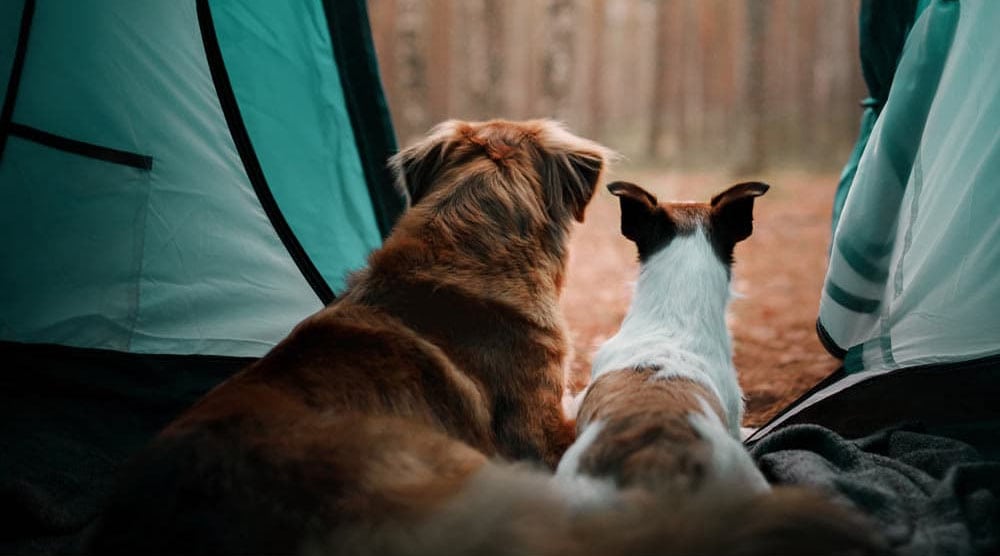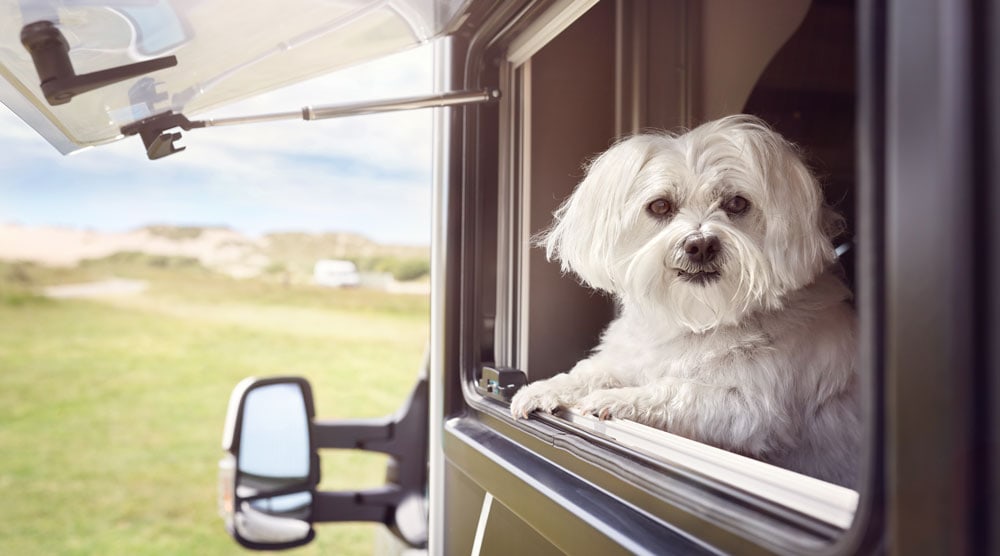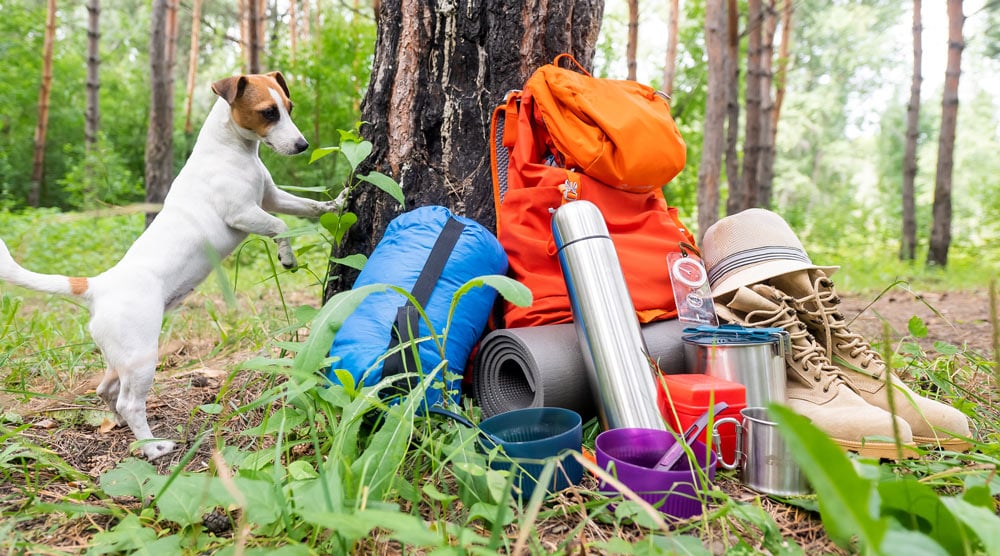Camping with a dog is a relatively cheap (and fun!) way to take a canine-friendly vacation. It’s important to be aware of the potential dangers though. Here are six examples, along with tips for keeping your pet safe.
Contents
It’s vital to properly research and understand the risks when camping though. From choosing a safe location to taking the right gear, preparation is key to a successful trip.
Before We Start…is Your Dog Suitable for Camping?
Not all dogs are suited to a camping vacation. You’ll need to consider your dog’s temperament, health and general behavior. Here are a few examples of dogs that probably aren’t suitable for camping:
- Puppies. A puppy can’t regulate his body temperature as effectively as an adult dog, so cold or hot weather is more dangerous. Young puppy’s growing bones also need restricted exercise to prevent future joint problems, so long hikes or other activities are off the menu. Camping could also be a challenge if they’re still toilet training. Dealing with an accident in the tent isn’t easy!
- Elderly Dogs. Senior pooches can also find it more difficult to cope in hot or cold weather. If they have joint issues, they may find camping uncomfortable and struggle with the increased activity levels.
- Reactive dogs. If you have a dog who reacts to other dogs or people, a busy camping environment could be overstimulating. Wild camping may be a possible alternative, though.
- Anxious Dogs. Some dogs become anxious or stressed more easily than others. An unfamiliar environment, wildlife, strangers and a different routine can make camping difficult for these dogs.
- Vocal Dogs. If your dog is an excitement or alert barker, taking them to a campsite is probably inconsiderate to other campers. Campsites have lots of strange noises, which are likely to set off your dog’s barking.
If you decide to take your dog camping, it’s important to get them used to the tent environment before an extended trip. Set it up in your garden first, then pair it with yummy treats, chews, comfy beds and interactive treat toys.
How to Keep Your Dog Safe When Camping
Research and planning are crucial when taking a dog on a camping trip. Some of the key considerations are outlined below.
1. Get a Pre-Camping Vet Checkup
If you’re planning a longer trip, organise a vet appointment several weeks before you go. Getting a clean bill of health for your dog is important, particularly if you’re camping in the wilderness or doing a long, strenuous trek.
Make sure your dog’s antiparasitic treatments are fully up to date. If you’re heading into terrain where there are lots of ticks, you may want to check if your dog’s current treatment is enough.
2. Bring Plenty of Clean Drinking Water and Food
Don’t underestimate the importance of a plentiful supply of fresh drinking water. Dogs overheat much more quickly than we do, and they may also be covering more ground than us when off the leash.
If you’re camping in the wilderness, you may need to use water purification and filtration devices. Don’t be tempted to let your dog drink from still water like ponds. Even slow-flowing rivers can harbour potentially lethal bacteria and toxic algae, especially in hot weather.
If you’re hiking, make sure you have enough extra water for your dog and that you offer them a drink at regular intervals, especially on hot days. You’ll want to pack a travel water bowl too.
Always pack enough of your dog’s regular food for the entire trip – plus some extra for emergencies. Your dog may need to be fed a little more than normal if you’re being particularly active. Changing their diet on a trip, especially if they have a sensitive tummy, could result in diarrhea and dehydration.
3. Keep Your Dog With You at All Times
Don’t be tempted to leave your dog in the tent when you’re hiking or doing another activity. They can easily overheat in a tent. Even if the temperature isn’t a problem, your dog could get stolen, cause damage, or become distressed.
Plan your activities with your dog in mind, and have a backup plan if weather, injuries or another external factor means your plans fall through.
Even when you’re with your dog in the campsite, make sure you always keep them on the leash, or tethered and supervised. The same is true in areas where there’s livestock.
Check if dogs are allowed in the places you plan to visit. Some areas in National Parks prohibit the entry of dogs, while others stipulate they need to be kept on leash. Be respectful of the rules that are in place – they’re there for a reason.
If you do have your dog off the leash, make sure they have a rock-solid recall. Always check they are microchipped and have an ID tag before you go on any trip – but especially in a new environment where your dog might be off leash.
If you’re concerned about it being an unfamiliar area, you could even use a smart collar for extra peace of mind.
4. Pack a Dog First Aid Kit
Regardless of how well you plan, accidents can happen. Be prepared and carry a dog first aid kit when camping, as you may not have immediate access to a vet. Some items that might come in handy include:
- A tick twister/remover
- An emergency blanket
- A soft, quick tie muzzle – just in case you need to move the dog when injured. A dog in pain is more likely to bite, so a muzzle can make transporting easier. Make sure you do positive reinforcement training with this before your trip, so your pet is happy to wear it.
- Bandages or vet wrap
- Scissors and self-adhesive tape
- An antiseptic, such as hydrogen peroxide
- Antibiotic spray or wipes
- A flashlight
- Any medication your dog may already use
Aside from first-aid essentials, you should also ensure your pet is comfortable during the trip. You may want to get a camping-friendly bed for your dog, for example. A crash-tested harness or crate is also important for driving.
5. Research Poisonous Plants and Dangerous Animals in the Area
Make sure you’re aware of hazardous flora and fauna in the area you’re visiting. While you can’t eliminate all risk, just being aware of the potential dangers in an area can help mitigate them.
A few examples include:
- If there’s a prevalence of poisonous wild plants and your dog is a prolific scavenger, you may want to alter your plans (or at least keep them on a leash.)
- If you have a short-coated dog, they could easily get a rash and inflammation as a result of contact with poison ivy. Should this happen, the dog will need to be rinsed down to reduce the irritation. With your vet’s guidance, you could also carry an antihistamine like Benadryl.
- Be aware of the types of snakes in the area. Know which ones are venomous and understand how to handle a snake bite. You should keep your dog on a leash in high-risk areas.
- You may want to pop a bear bell on their collar, as the noise can scare off nearby critters (although be aware that this won’t apply to snakes as they don’t hear well.)
6. Make Sure Your Dog is a Safe Temperature
One of the biggest concerns, especially in the summer months, is keeping your dog at a comfortable temperature.
Dogs overheat quickly, and life-threatening heatstroke can take owners by surprise. This is even more relevant for flat-faced, brachycephalic breeds like Pugs and French Bulldogs.
Be sure that you don’t take them off on a strenuous hike in hot weather. Make sure your tent is in a shady spot, that you keep your dog well hydrated, and you may even want to bring along a cooling vest or mat.
Overheating isn’t the only concern though – cool temperatures can also be dangerous.
Even in the summer months, the temperatures can drop drastically at night. Make sure your dog will be warm enough, let them sleep in the tent with you and bring along a practical doggy coat or fleece if you think they will need it.
Summary
A camping trip with your dog can be a great way for you both to get away and enjoy an adventure. Spending time together can also strengthen your bond and give your dog fun new experiences.
With planning and research, you can reduce or eliminate many risks when camping. It’s also important to be honest about whether your dog is suitable for a camping trip. If he probably won’t enjoy the trip, it’s best to leave him with a family member or trusted dog sitter.
Keeping your dog hydrated and at a safe temperature is essential when camping. This is often a challenge in the unpredictable outdoors, so be prepared for all situations.
Planning to go RVing instead of camping? Check out our guide to safely RVing with your pet.




